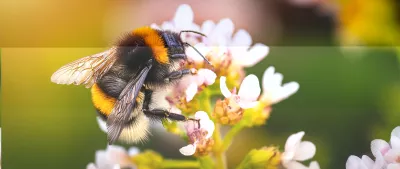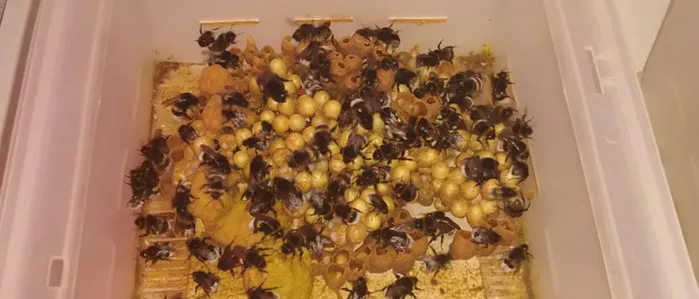General information
RDP Priority
- P4. Ecosystems management
RDP Focus Area
- 4A: Biodiversity restoration, preservation & enhancement
RDP Measure
- M16: Cooperation
Beneficiary type
- Operational group
Summary
The research project focused on Bombus Terrestris, one of Europe's most widespread bumblebee species, which is effectively used in greenhouse pollination. Sweden depends to a large extent on imports of bumblebee hives from abroad, which carries a number of health risks for the bumblebee population. Previous attempts failed to grow Bombus Terrestris commercially in Sweden aimed at replacing the long-distance imports. This prompted a Swedish team of entrepreneurs, farmers, agronomists, researchers and beekeepers to try again. The main idea was to focus more specifically on the bumblebees’ life cycle, environmental requirements and needs.
European Agricultural Fund for Rural Development (EAFRD) supported the research project, which tested approaches to producing Bombus Terrestris commercially in Sweden. The overall aim was to substitute imports, increase the health of bumblebee populations, and prevent diseases and genetic mixing.
Results
- Attainment of skills and competencies to produce bumblebee hives commercially in Sweden by using Swedish pollen.
- The commercial product, i.e. locally grown bumblebees, is on the market and available for growers.
- Sweden and the national food strategy benefit from increased self-sufficiency and reduced vulnerability due to increased domestic production of pollinators.

Funding
RDP support: 3 484 430 (SEK)
Resources
Documents
Good Practice Report - Odling av svenska pollinatörer (Cultivation of Swedish pollinators)
(PDF – 1.01 MB)
Links
Context
Bombus Terrestris is one of Europe's most widespread bumblebee species and is effectively used in greenhouse pollination. So far, they need to be imported or caught in the wild and then transported to the relevant farmer/vegetable producer who needs them for pollination. This process is not ideal as it has a number of health risks for the bumblebees. Previous attempts to grow bumblebees commercially in Sweden aimed at replacing the long distance imports that carry the risk of genetic mixing and introducing foreign diseases to Swedish Bombus Terrestris. However, the attempts to produce the bumblebees commercially in Sweden have failed. This prompted a Swedish team of entrepreneurs, farmers, agronomists, researchers and beekeepers to try again. The idea was to focus more specifically on the bumblebees’ life cycle and their environmental requirements and needs, particularly in relation to the quality of the bumblebee hives and other characteristics.
By offering the Swedish market locally produced bumblebee hives, the risk of genetic mixing and introducing foreign diseases would be reduced. The shorter transport distances would also mean the bumblebees remain healthier and less vulnerable.
Objectives
The main objective of the project was to research and test approaches to producing Bombus Terrestris commercially in Sweden. The overall aim was to substitute imports of bumblebees for pollination purposes, thereby ensuring healthier bumblebee populations and preventing diseases and genetic mixing through imports.
In addition, the intention was to bring about a number of advantages through domestic cultivation of bumblebees, such as locally grown produce, reduced transport, and an increased degree of self-sufficiency with less vulnerability in production and supply chain.
The aim was to use Swedish pollen in the project to minimise the risk of infections being carried over that are not found in Sweden yet.
Activities
The main activities of the research project were to learn specifically about the conditions of the (bumblebee) queen's life cycle and to test and assess the conditions in hives that would create the most favourable growing environment for Bombus Terrestris.
In addition, the project included the development of a marketing plan. The procurement and identification of suitable purchasing channels was a further dedicated task as the project's materials were often unusual or uncommon and, therefore, difficult to find or had to be built from scratch.
The overall research results, including the working process and the creation of the ideal growth environment, were evaluated and relevant process descriptions and manuals were developed.
The testing of the bumblebee hives and their growing conditions was followed up with publications in journals supported by relevant statistics.
Across all project research tasks, contacts with researchers and producers in other countries were established.
Main results
- Attainment of skills and competencies to produce bumblebee hives commercially in Sweden using Swedish pollen.
- The commercial product, i.e. locally grown bumblebees, is on the market and available for growers.
- Post-project, bumblebee cultivation is now run by a company in Skåne, which has started selling bumblebee hives on a small scale.
- A number of environmental benefits have been achieved through the use of Swedish pollen, including a reduction in the risk of genetic interference among Swedish B. Terrestris, a reduced need for transport, and a reduced risk of imported infections in bumblebee populations.
- Sweden and the national food strategy benefit from increased self-sufficiency and reduced vulnerability due to increased domestic production of pollinators.
- Larger domestic bumblebee production requires more pollen. This provides employment for pollen producers.
- The project has created transferable knowledge for growing and supporting other species of bumblebees.
- Swedish researchers plan to conduct further research in the future to study the impact of climate change and plant toxins on Swedish pollinators.
Key lessons
- The interest and demand to buy bumblebee hives is very high, but it takes a long time to build up a breeding stock to sell larger quantities.
- The project enabled participants to learn how to identify risks that pandemics can create in terms of staffing, which can mean a skewed workload distribution. The COVID-19 crisis demonstrated how vulnerable it is to be dependent on imports. If there is a pandemic again, Sweden will now be self-sufficient and thus continue to produce food efficiently.
- During the pandemic years, society has become increasingly aware of the implications of a lack of pollinators and the risks of invasive species. This makes the production of domestic bumblebees feel even more important.
- Dealing with the relevant administrative authorities was time-consuming and required patience and stamina.
